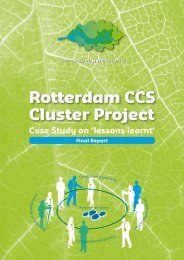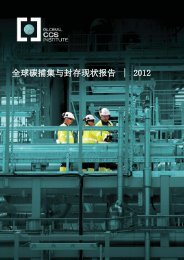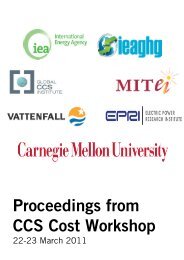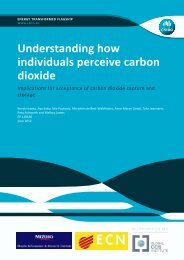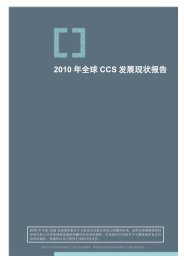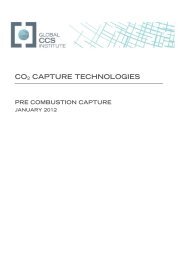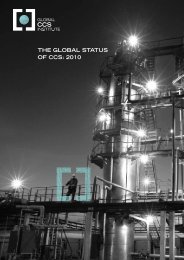CO2 capture technology selection methodology - Global CCS Institute
CO2 capture technology selection methodology - Global CCS Institute
CO2 capture technology selection methodology - Global CCS Institute
You also want an ePaper? Increase the reach of your titles
YUMPU automatically turns print PDFs into web optimized ePapers that Google loves.
+CO 2 <strong>capture</strong> <strong>technology</strong><strong>selection</strong> <strong>methodology</strong>Special report for the <strong>Global</strong> Carbon Capture and Storage <strong>Institute</strong>ROAD | Maasvlakte <strong>CCS</strong> Project C.V.September 2011CO 2 <strong>capture</strong> <strong>technology</strong>
Maasvlakte <strong>CCS</strong> Project C.V.TitleCO 2 <strong>capture</strong> <strong>technology</strong> <strong>selection</strong> <strong>methodology</strong>Special report for the <strong>Global</strong> Carbon Capture and Storage <strong>Institute</strong>AuthorsGerbert van der WeijdeGuus van de SchouwDate19 September 2011 (revised version)ROAD | Maasvlakte <strong>CCS</strong> Project C.V.Parallelweg 1 P.O. Box 1333112 NA Schiedam 3100 AC SchiedamThe NetherlandsThe NetherlandsTel: +31 10 75 34 000Fax: +31 10 75 34 040E-mail: info@road2020.nlWeb: www.road2020.nlDisclaimerThe ROAD project is co-financed by the Government of the Netherlands, the <strong>Global</strong> Carbon Capture andStorage <strong>Institute</strong> and the European Commission under the European Energy Programme for Recovery.The sole responsibility for the content of this publication lies with Maasvlakte <strong>CCS</strong> Project C.V.This report for the ROAD project is being provided pursuant to the funding agreement between the<strong>Global</strong> Carbon Capture and Storage <strong>Institute</strong> and Maasvlakte <strong>CCS</strong> Project C.V. The provisions of thatfunding agreement are for the sole protection and legal benefits of the parties thereto, unless otherwiseagreed in writing. No other person or entity shall have any direct cause of action or claim against any ofthe parties to that funding agreement arising from the publication, disclosure or distribution of this reportand/or the utilization of or reliance on the content of this report.This document is published on the <strong>Global</strong> <strong>CCS</strong> <strong>Institute</strong>'s website in the interest of information exchange.The <strong>Global</strong> <strong>CCS</strong> <strong>Institute</strong> does not give any representation or warranty as to the reliability, accuracy orcompleteness of the information, nor does it accept any responsibility arising in any way (including bynegligence) for errors in, or omissions from, the information.©<strong>Global</strong> Carbon Capture and Storage <strong>Institute</strong> Limited 2011 Canberra. Use of this document is permittedin accordance with Creative Commons Attribution 3.0 Australia License.CO 2 <strong>capture</strong> <strong>technology</strong> <strong>selection</strong> <strong>methodology</strong>
Maasvlakte <strong>CCS</strong> Project C.V.Table of contentsExecutive summary .............................................................................................................................. 11. Introduction ................................................................................................................................. 32. Project factsheet ........................................................................................................................... 42.1 Project Overview 42.2 Maasvlakte <strong>CCS</strong> Project C.V. 72.3 Intended Partners 82.4 Financial contributors 83. CO 2 <strong>capture</strong> <strong>technology</strong> <strong>selection</strong> process ...................................................................................... 93.1 Constraints 93.2 Considerations in designing the <strong>selection</strong> process 103.3 Selection process 114. Evaluation criteria & process ....................................................................................................... 144.1 Evaluation of the proposals for preliminary studies 144.2 Evaluation of the preliminary study phase 154.3 Evaluation of the FEED studies phase 165. Lessons learned .......................................................................................................................... 185.1 Working in a joint venture 195.2 Supplier <strong>selection</strong> strategy 195.3 Decision making and timing 205.4 Selection criteria 205.5 Managing relationships with suppliers 20Abbreviations ..................................................................................................................................... 21Appendix 1 – Capture <strong>technology</strong> <strong>selection</strong> process ............................................................................ 22Appendix 2 – Ranking matrix proposals ............................................................................................... 23Appendix 3 – Ranking matrix preliminary studies ................................................................................ 24Appendix 4 – Ranking matrix final supplier <strong>selection</strong> ........................................................................... 25CO 2 <strong>capture</strong> <strong>technology</strong> <strong>selection</strong> <strong>methodology</strong>
Maasvlakte <strong>CCS</strong> Project C.V.Executive summaryIn July 2009 Maasvlakte <strong>CCS</strong> Project C.V. (‘MCP’) submitted a project proposal to the EuropeanCommission. This marked the start of the ‘ROAD project’ (‘Rotterdam Opslag en AfvangDemonstratieproject’; Rotterdam Storage and Capture Demonstration project). By applying forEuropean funding, ROAD committed itself to the funding program requirements, mainly relatedto the project schedule. The project team had to select a post combustion <strong>capture</strong> plantsupplier within the given time constraints, while still respecting other important constraints. Forthis reason, the project team developed a tailor made <strong>selection</strong> <strong>methodology</strong>.The main constraints on the design of the <strong>selection</strong> <strong>methodology</strong> can be allocated to thefollowing categories:• schedule (funding related, e.g. timing of commitments and operational date);• cost (funding requires proving value for money, business case should be acceptable);• health, safety & environment (emissions; permitting process); and• <strong>technology</strong> (performance, potential for improvement, ability to deliver).Respecting the constraints, the following considerations were taken into account whendesigning the <strong>selection</strong> <strong>methodology</strong>:• Competition between suppliers should be maintained as long as possible (commercialreasons, avoiding the situation that no supplier would remain and demonstrating bestvalue for money).• Applying <strong>technology</strong> with a proven track record (on pilot scale or in other industries)maximizes the chance that the plant will perform as predicted on this scale and in thiscontext.• Selecting a supplier that can offer both <strong>technology</strong> and engineering and constructingcapabilities reduces ROAD’s co-ordinating efforts and related risks.• Technical and commercial risks should be allocated to the suppliers, as they are in thebest position to evaluate these risks.Based on both constraints and the considerations a <strong>selection</strong> process consisting of three stepswas designed. In each of these phases the technical design was further detailed and thecommercial terms were further elaborated, whilst the number of eligible suppliers wassimultaneously reduced from nine initial candidates to one selected supplier.The <strong>selection</strong> between each of the phases was performed in a workshop in which professionalsfrom various professional backgrounds participated. The main <strong>selection</strong> criteria applied were:• technical confidence;• ability to permit;• project delivery;• commercial conditions;• economics; and• effectiveness of <strong>technology</strong> demonstration.CO 2 <strong>capture</strong> <strong>technology</strong> <strong>selection</strong> <strong>methodology</strong> 1
Maasvlakte <strong>CCS</strong> Project C.V.In the first and second <strong>selection</strong> step technical confidence (mainly supplier experience) playedthe most important role. In the final <strong>selection</strong> step technical confidence was not a realdifferentiator anymore; here economics and potential permitting issues were decisive.In a lessons learned workshop the <strong>selection</strong> <strong>methodology</strong> was discussed. The project team feelsthat both the <strong>selection</strong> process and the outcome of the process were satisfactory. The projectteam drew a number of lessons from the <strong>selection</strong> process, related to:• benefits and challenges caused by working in a joint venture;• the <strong>selection</strong> strategy in general;• decision making and timing;• <strong>selection</strong> criteria; and• the importance of managing relationships with suppliers.CO 2 <strong>capture</strong> <strong>technology</strong> <strong>selection</strong> <strong>methodology</strong> 2
Maasvlakte <strong>CCS</strong> Project C.V.2. Project factsheet2.1 Project OverviewROAD is the Rotterdam Opslag and Afvang Demonstratieproject (Rotterdam Capture andStorage Demonstration Project) and is one of the largest integrated Carbon Capture and Storage(<strong>CCS</strong>) demonstration projects in the world.2.1.1 Project objectivesThe main objective of ROAD is to demonstrate the technical and economic feasibility of a largescale,integrated <strong>CCS</strong>-chain. In the power industry, to date, <strong>CCS</strong> has primarily been applied insmall-scale test facilities. Large-scale demonstration projects are needed to show that <strong>CCS</strong> is anefficient and effective CO 2 abatement <strong>technology</strong> within the next 5 to 10 years. With theknowledge, experience and innovations gained by projects like ROAD, <strong>CCS</strong> could be deployed ona larger and broader scale: not only on power plants, but also within energy intensive industries.<strong>CCS</strong> is one of the transition technologies expected to make a substantial contribution toachieving climate objectives.2.1.2 PartnersROAD is a joint project initiated by E.ON Benelux N.V. and Electrabel Nederland N.V. (GDF SUEZGroup). Together they constitute the limited partnership Maasvlakte <strong>CCS</strong> Project C.V. Theintended partners of ROAD are GDF SUEZ E&P Nederland B.V. for the CO 2 transport and TAQAEnergy B.V. for the CO 2 injection and permanent storage. The ROAD-project is co-financed bythe Government of the Netherlands, the European Commission within the framework of theEuropean Energy Programme for Recovery (EEPR) and the <strong>Global</strong> <strong>CCS</strong> <strong>Institute</strong>.2.1.3 Project specificationsROAD applies post combustion <strong>technology</strong> to <strong>capture</strong> the CO 2 from the flue gases of a new1,100 MWe coal-fired power (Maasvlakte Power Plant 3) in the port and industrial area ofRotterdam. The <strong>capture</strong> unit has a capacity of 250 MWe equivalent and aims to <strong>capture</strong> 1.1million tonnes of CO 2 per year. The <strong>capture</strong> installation is planned to be operational in 2015.Location of the ROAD-project <strong>CCS</strong> chain: Rotterdam port and industrial area and North SeaCO 2 <strong>capture</strong> <strong>technology</strong> <strong>selection</strong> <strong>methodology</strong> 4
Maasvlakte <strong>CCS</strong> Project C.V.Location of the <strong>capture</strong> unit: Maasvlakte Power Plant 3 (photo: E.ON)From the <strong>capture</strong> unit the CO 2 will be compressed and transported through a pipeline: 5kilometers over land and 20 kilometers across the seabed to the P18 platform in the North Sea.The pipeline has a transport capacity of around 5 million tonnes per year. It is designed for apressure of 175 bar and a maximum temperature of approximately 80 °C.ROAD plans to store the <strong>capture</strong>d CO 2 in depleted gas reservoirs under the North Sea. These gasreservoirs are located in block P18 (P18-6, P18-4 and P18-2) of the Dutch continental shelf,approximately 20 kilometers off the coast. The depleted gas reservoirs are at a depth of around3,500 meters under the seabed of the North Sea. The CO 2 will be injected from the platform intodepleted gas reservoirs. The estimated storage capacity is approximately 35 million tonnes.2.1.4 Rationale for Rotterdam port and industrial areaThe Rotterdam port and industrial area has a number of advantages that create favorableconditions to implement a <strong>CCS</strong> demonstration project like ROAD. The Rotterdam port andindustrial area has many CO 2 point sources. Several new power stations prepared for theapplication of <strong>CCS</strong> (<strong>capture</strong> ready) are under construction. The Port of Rotterdam is relativelyclose to a large number of (almost) depleted gas reservoirs on the continental shelf under theNorth Sea, allowing for a small transport distance. These gas reservoirs meet the physical andgeological properties for CO 2 storage and will become available in the next few years (from 2014onwards). The Netherlands has a lot of knowledge and experience with both oil and gasextraction and storage of gas in aquifers and gas reservoirs. In addition, the complete <strong>CCS</strong>-chainis remote from residential areas.250 MWe <strong>capture</strong> unit (post-combustion)CO 2 <strong>capture</strong> <strong>technology</strong> <strong>selection</strong> <strong>methodology</strong> 5
Maasvlakte <strong>CCS</strong> Project C.V.2.1.6 PlanningThe high level schedule of the ROAD project is as follows:14 July 2009 : Application submitted for funding under European Energy Programme forRecoverySeptember 2009 :Project selected for funding by European CommissionMay 2010 : Ministerial order Dutch funding publishedSeptember 2010 :: Grant Agreement signed by European Commission and ROAD ProjectFront-End Engineering Design studies Capture Plant completedStarting note Environmental Impact Assessment publishedJune 2011 : Submitting Environmental Impact Assessment, permit applicationsQ4 2011 : Final Investment DecisionQ4 2011 : Start execution phase (procurement, construction, etc.)2014 : <strong>CCS</strong> chain mechanically complete2015 : Start of operation <strong>CCS</strong> chain2015-2019 : Demonstration operation phase <strong>CCS</strong> chain2020 : Start commercial operation <strong>CCS</strong> chain2.2 Maasvlakte <strong>CCS</strong> Project C.V.The initiating parties of the ROAD project are E.ON Benelux and Electrabel Nederland / GDFSUEZ Group. Together they constitute the limited partnership Maasvlakte <strong>CCS</strong> Project C.V.2.2.1 E.ON BeneluxE.ON Benelux concentrates on the production and supply of electricity and gas to privatecustomers and business customers in the Netherlands and Belgium. E.ON Benelux is primarily anelectricity-generating company; the company can trade internationally and has its ownprofessional sales organisation. The company was established in 1941 and since 2000 has beenpart of E.ON Energie AG. E.ON Benelux’s power stations with a total capacity of 1,850 MW arelocated in the province of South Holland, the economic heart of the Netherlands. The companyhas approximately 600 employees. E.ON Benelux is based in Rotterdam.2.2.2 Electrabel NederlandElectrabel Nederland is a leading player in the Dutch energy market and part of the GDF SUEZGroup. With six state-of-the-art production locations and a total capacity of 5,103 MWElectrabel is the largest electricity producer in the Netherlands. Electrabel is a supplier ofelektricity and gas to both private and business customers. Electrabel Nederland has 1,250employees.CO 2 <strong>capture</strong> <strong>technology</strong> <strong>selection</strong> <strong>methodology</strong> 7
Maasvlakte <strong>CCS</strong> Project C.V.2.3 Intended PartnersIntended partners of Maasvlakte <strong>CCS</strong> Project C.V. are GDF-SUEZ E&P Nederland B.V. for the CO 2transport and TAQA Energy B.V. for the CO 2 -injection and the permanent storage under the seabed of the North Sea.TAQA EnergyTAQA Energy is part of the Abu Dhabi National Energy Company PJSC (TAQA), an energycompany that has worldwide interests in power generation, combined heat and water,desalination, upstream oil & gas, pipelines, services and structured finance. TAQA has aworkforce of 2,800 employees and is located in Abu Dhabi, The Hague, Ann Arbor: Michigan,Aberdeen, Calgary and Amsterdam. In addition, TAQA has sustainable partnerships withcompanies in Africa, the Middle-East, Europe, North-America and India. TAQA is listed at theAbu Dhabi Securities Exchange (ADX).In the Netherlands, TAQA Energy explores and produces gas and condensates from wellslocated onshore in the Alkmaar region and offshore in the Dutch North Sea. TAQA also operatesa gas storage facility in Alkmaar and has interests in Dutch North Sea pipelines. 200 people workfor TAQA directly and indirectly in the Netherlands both onshore and offshore.GDF SUEZ E&P NederlandGDF SUEZ E&P Nederland is one of the largest operators in the Dutch sector of the North Sea.With more than thirty production platforms and 300 employees, it is at the basis of theprovision of energy to the Netherlands and several other countries.Since its first successful drilling results in the Dutch North Sea, approximately forty years ago,GDF SUEZ E&P Nederland has grown into a leading operator. It has ample expertise andexperience, always chooses the safest option and is continuously working towards thedevelopment of new techniques and improved methods. Continuity is ensured throughexploration, takeovers and acquisition.2.4 Financial contributorsThe ROAD-project is co-financed by the European Commission within the framework of theEuropean Energy Programme for Recovery (“EEPR”), the Government of the Netherlands andthe <strong>Global</strong> <strong>CCS</strong> <strong>Institute</strong>.In response to the economic crisis, the European Council and the European Parliament adoptedthe Commission proposal for a European Energy Programme for Recovery (“EEPR”) in July 2009.The EEPR funds projects in the field of gas and electricity infrastructure as well as offshore windenergy and CO 2 <strong>capture</strong> and storage (<strong>CCS</strong>). In total 12 <strong>CCS</strong> projects applied for assistance underthe EEPR. In December 2009, the European Commission granted financial assistance to sixprojects that could make substantial progress with project development in 2010. These projectswill receive overall funding of € 1 billion under the EEPR.CO 2 <strong>capture</strong> <strong>technology</strong> <strong>selection</strong> <strong>methodology</strong> 8
Maasvlakte <strong>CCS</strong> Project C.V.3. CO 2 <strong>capture</strong> <strong>technology</strong> <strong>selection</strong> processApplying for EEPR funding imposed strict constraints on ROAD with respect to the timing ofplacing its major contracts. This was one of the main drivers behind the design of the <strong>selection</strong>process. In this chapter, constraints and considerations taken into account in designing theprocess are explained. The <strong>selection</strong> <strong>methodology</strong> based upon these conditions andconsiderations is subsequently described.3.1 ConstraintsSchedule related constraints, due to EEPR funding, were already introduced. Other sets ofconstraints are related to cost, health, safety & environment (‘HSE’) and <strong>technology</strong> aspects.Each of these sets is described below. It will become clear that most schedule and cost relatedcriteria are related to the funding the project applied for, whereas <strong>technology</strong> and HSE relatedcriteria are more related to the current state of <strong>capture</strong> <strong>technology</strong>.3.1.1 Schedule• Capture plant contract to be signed in 2010 – In the EEPR proposal ROAD committeditself to awarding the engineering, procurement and construction (‘EPC’) for the <strong>capture</strong>plant in 2010, because stimulating economic recovery was one of the main goals of theEEPR and making early commitments to major contracts was an important <strong>selection</strong>criterion for the EEPR program.• Funding available for a maximum of five years – Ideally all project expenditures are tobe made within five years, as EEPR funding only covers expenditures made within thefirst five years of the agreement. As the ROAD project funding commenced on 1 January2010, costs made until 31 December 2014 are eligible.• <strong>CCS</strong> chain to be operational by 2015 – The <strong>CCS</strong> chain should be operational before theend of 2015 to be eligible for EEPR funding.3.1.2 Cost• Best value for money – As a funding requirement, ROAD should be able to demonstratethat the selected <strong>capture</strong> plant supplier will provide ‘best value for money’. This meansthat clear evidence should exist that the selected supplier offers at least the requiredquality at the lowest cost available in the market.• Having an acceptable business case – Investment and operational costs should not beunacceptably high to the partners in Maasvlakte <strong>CCS</strong> Project C.V. Funding will cover onlypart of the project cost, all extra costs will be borne by the project initiators.3.1.3 Health, safety & environment• Emissions, effluents and waste streams – The supplier should have proven insight inthe (levels of) emissions and effluents of substances which might pose a threat to publicsafety or to the environment. The supplier should furthermore have a convincingapproach to guarantee that these emissions and effluents stay within acceptable levels.The supplier should also have good insight in waste streams and an approach that willreduce waste streams to the lowest possible quantities.• Permitting process requirements – To obtain a permit for the <strong>capture</strong> plant, not onlyshould the emissions be known and be within acceptable levels, the supplier should alsobe prepared to share proprietary information with the competent authorities to enablethem to verify the supplier’s claims and make a sound permitting decision.CO 2 <strong>capture</strong> <strong>technology</strong> <strong>selection</strong> <strong>methodology</strong> 9
Maasvlakte <strong>CCS</strong> Project C.V.3.1.4 Technology• Comfort on technical performance and operability – As this is a demonstration project,it inherently involves technical risks. However, sufficient comfort on eventualperformance of the <strong>capture</strong> plant (e.g. through guarantees, prior experience, etc.) is aprerequisite for taking the final decision to invest in the project.• Foreseen inability of suppliers to directly deliver an EPC proposal – Based upon signalsfrom the supplier market, it was foreseen that directly going to the market with arequest for binding EPC offers based upon prescribed specifications would not besuccessful, as it would require the suppliers to conduct expensive prior studies at theirown cost. Given the risk of not being selected, suppliers might not want to make thoseinvestments and either would not participate in the process or simply offer an EPCcontract which would be unacceptably expensive.• Technological potential – A modest energy penalty is required to keep operating costslow (see 3.1.2). Significant supplier research and development activities provide achance to reduce the penalty even further later in the process (e.g. through improvedsolvents).3.2 Considerations in designing the <strong>selection</strong> processOne of the most important aspects of the designed <strong>selection</strong> process was maintainingcompetition as long as possible, preferably until the EPC price was fixed and agreed upon. Thiswas done for the following reasons:• A lack of competition would improve the negotiating position for the supplier,potentially driving up the EPC price for the <strong>capture</strong> plant.• Keeping different technologies in the process reduced the chance that at some point intime ROAD would be left with no <strong>capture</strong> plant supplier, e.g. due to emission problems,and ROAD would have to go through a new <strong>selection</strong> process, introducing unacceptabledelays.• Demonstrating best value for money is done best by applying measurable <strong>selection</strong>criteria on multiple offers.Maintaining competition inherently comes at a cost as it requires duplicating work. Finding theright balance between increased costs for the process (short term) and reduced cost asoutcome of the process (long term) was key. Upfront it was difficult to foresee the exactdynamics of the process. Recognizing this, the decision was made to fix the process, but leavesome freedom in the numbers of suppliers entering the different phases. Strictly following theEuropean tender procedures was not possible for the <strong>capture</strong> plant, as this would be too timeconsuming and costly.Technological potential and comfort on performance are to some extent conflicting conditions.A large number of <strong>capture</strong> <strong>technology</strong> suppliers are interested in bringing their <strong>technology</strong> tothe market on demonstration scale. Some of them have promising technologies, but have onlyapplied them on lab-scale. Others have relatively extensive experience on pilot or evenindustrial scale, but the <strong>technology</strong> applied in these installations is often not the <strong>technology</strong>with the best predicted performance. Given the large size of the <strong>capture</strong> plant (first of its kind)and the required startup of the <strong>CCS</strong> chain in 2015, ROAD decided to opt for <strong>technology</strong> with astrong track record, to reduce risks, while the partners in MCP will continue performing pilotprojects on a smaller scale with the more novel technologies.CO 2 <strong>capture</strong> <strong>technology</strong> <strong>selection</strong> <strong>methodology</strong> 10
Maasvlakte <strong>CCS</strong> Project C.V.Looking at the constraints it can be seen that some of them are related to the technologicalconcept of the plant, whereas others are more related to engineering or construction. Some<strong>technology</strong> suppliers have preferred EPC contractors to work with; others are EPC contractorswhich have developed their own <strong>capture</strong> <strong>technology</strong>. Knowing this, it would be possible forROAD to assume the responsibility for coordinating between a separate <strong>technology</strong> supplier andcontractor. However ROAD chose to allow only companies or consortia offering the full<strong>technology</strong> and EPC package to participate in the <strong>selection</strong> process. Bidding consortia wererequired to nominate a single point of responsibility / contact for ROAD. For simplicity, bothsingle companies and consortia participating in the <strong>selection</strong> process will be referred to as“suppliers”.One of the remaining considerations was to go for either an open book contract or a lump sumturnkey contract. If the parent companies would have been familiar with the <strong>technology</strong> on thisscale, an open book approach would have been preferred, to keep costs low. However, as thesuppliers are in a better position to evaluate potential risks with cost impact, cost certaintywould be much improved by allocating the technical and financial risks to the consortia. Thisapproach clearly would have been viable only if sufficient incentives existed for the consortia tooffer a competitive EPC price.3.3 Selection processAfter evaluating the pros and cons of various possible <strong>selection</strong> processes 1 , it was decided toperform the <strong>technology</strong> <strong>selection</strong> following a phased process. A schematic overview of the<strong>selection</strong> process is provided in appendix 1. It consisted of the following phases:I. proposals for preliminary studies;II.III.preliminary studies; andfront-end engineering design (‘FEED’) studies / EPC bids.Each phase of the <strong>selection</strong> process will be discussed separately below.3.3.1 Proposals for preliminary studiesA total of nine suppliers (all of them suppliers known to the two partners in Maasvlakte <strong>CCS</strong>Project C.V. who were to some extent deemed capable of delivering the eventual <strong>capture</strong> plantusing post-combustion <strong>capture</strong> <strong>technology</strong>) were invited to submit a proposal for a preliminarystudy. This proposal was to include:• demonstration of the supplier’s experience on lab-scale, pilot-scale and industrial scale;• demonstration of the supplier’s ability and willingness to comply with the proposedproject strategy; and• an offer for a preliminary study as specified.The motive for including the second requirement might not be obvious. ROAD realized that thetime constraints it had and would demand from its suppliers were very tight. To manageexpectations and thereby avoid future issues in compliance with the strategy, ROAD asked thesupplier’s explicit attention for the strategy and resulting schedule constraints via the requesteddemonstration of willingness to comply.1 The basic <strong>selection</strong> approaches considered were:(1) directly bidding for EPC contract (one contracting party);(2) FEED study and EPC bid (paid by supplier) (one contracting party);(3) FEED study by <strong>technology</strong> supplier (paid by JV), subsequent EPC tendering (two contracting parties);(4) FEED study and EPC bid by supplier (paid by JV) (one contracting party); and(5) preliminary study (paid by supplier), subsequent FEED study and EPC bid (paid by JV) (one contracting party)CO 2 <strong>capture</strong> <strong>technology</strong> <strong>selection</strong> <strong>methodology</strong> 11
Maasvlakte <strong>CCS</strong> Project C.V.The companies had approximately one month to come up with these proposals. Beforehand, aninformation session was held with each of the invited suppliers. In the information sessions,organized at the airport to enable efficient face-to-face meetings with all suppliers within ashort timeframe, ROAD presented its project and the envisaged <strong>technology</strong> <strong>selection</strong> process,with a specific focus on what was expected from the suppliers in the proposal phase. After thepresentation a Q&A session enabled the suppliers to get clarity on any issue deemed relevant.Technical, commercial, legal and project management representatives from ROAD wereavailable to answer the questions. Through the information sessions ROAD successfully alignedexpectations on the requested proposals and on the <strong>selection</strong> process in general with thesuppliers. This ensured supplier buy-in for the <strong>selection</strong> process and enhanced the quality of theproposals submitted.The schedule did not allow lengthy contract negotiations for preliminary study contracts.Therefore ROAD informed the suppliers that the studies would need to be offered free ofcharge. Eventually all suppliers submitted a proposal for a preliminary study. Given the time andbudget limitations, this clearly shows the suppliers’ interest in getting a stronger position in themarket by being involved in the project and their resulting willingness to make offers for stayingin the competition.3.3.2 Preliminary studiesBased upon the proposals for preliminary studies, a ranking of the suppliers was made (theevaluation process is discussed in section 4.1). The three most promising projects were invitedto perform preliminary studies for the ROAD project. Numbers four through six were informedthat the likelihood that they would be selected for performing a FEED study after thepreliminary studies was very small, but that – if they wanted – they could perform thepreliminary studies. All of them did, despite the fact that the costs for the studies could not berecovered in case the bid was not successful. The three lowest ranking bids were immediatelyrejected, offering an explanation to the rejected suppliers if desired.To enable fair comparison between the different bidders, the suppliers were asked to design a<strong>capture</strong> plant ‘within battery limits’ with the battery limit conditions for utilities identical for allsuppliers. At the end of the preliminary study phase the suppliers were expected to deliver:• preliminary technical deliverables, amongst which for example:o various diagrams (process flow diagrams, piping and instrumentation diagrams,utility flow diagrams, electrical one-line drawings);o sized equipment list;o technical process description;o heat and mass balances;o overview of solvent characteristics; ando safety specifications (materials safety data sheets, atmospheric emissions, liquideffluents, solid waste streams, chemical storage volumes);• a technical and commercial proposal for a FEED study;• preliminary performance guarantees; and• a budget estimate for the intended EPC contract (lump sum turnkey).The suppliers had approximately two months for performing the preliminary studies. Allsuppliers complied with the agreed upon timeframe.CO 2 <strong>capture</strong> <strong>technology</strong> <strong>selection</strong> <strong>methodology</strong> 12
Maasvlakte <strong>CCS</strong> Project C.V.3.3.3 Front-end engineering design studiesTo ensure that agreements with two suppliers could be signed in time, technical andcommercial clarification and negotiation rounds were held with the three suppliers thatdelivered the most promising preliminary studies. FEED study agreements were subsequentlysigned with two of these parties. The FEED phase ran for six months.It was decided to perform two parallel FEEDs to keep competitive tension in and maintainquality. Performing three or more FEEDs would have led to a significant cost increase(approximately six million euro per FEED, inclusive project management and suppliersupervision) and spread ROAD’s technical and project management expertise too thin.The deliverables that were part of the FEED studies were divided in the following categories:• general and project management (design basis, project implementation plan, projectmanagement procedures, quality assurance plan, guarantees, material <strong>selection</strong>philosophy, cost estimates, etc.);• process design (incl. report on emissions, waste streams and waste disposal);• HSE (incl. HAZOP);• mechanical (equipment, compressor);• piping;• architectural, civil, structural;• HVAC;• layout;• electrical;• control and instrumentation; and• communication and alarm system.These categories were divided in subcategories, each containing a number of deliverables. Foreach of the deliverables at least two mandatory review moments were scheduled. An overviewcontaining all requested deliverables and the review planning was distributed to the suppliersprior to the FEED studies. The performance to schedule of the requested deliverables andcorresponding milestones were strictly monitored and supervised. Each of the two suppliersperforming a FEED study got assigned a dedicated FEED coordinator from within the ROADproject team. These FEED coordinators acted as liaisons between the suppliers and the projectteam, to ensure all issues were quickly resolved, as the tight schedules did not allow for anydelays.Based upon the technical deliverables, the suppliers were requested to make a binding offer foran EPC contract (lump sum turnkey) and give process, performance, emissions and delivery time(incl. construction and commissioning) guarantees. Starting three months after commencementof the FEED studies, negotiations on the EPC contract were conducted with both suppliers, toensure all commercial conditions could be included as ranking criteria in the final supplier<strong>selection</strong> and the EPC contract could be signed as soon as ROAD would have selected itspreferred supplier and taken its final investment decision. These negotiations were led by thetechnical project manager <strong>capture</strong> (supported by technical experts) and the commercial projectmanager <strong>capture</strong> (supported by legal and procurement experts).CO 2 <strong>capture</strong> <strong>technology</strong> <strong>selection</strong> <strong>methodology</strong> 13
Maasvlakte <strong>CCS</strong> Project C.V.4. Evaluation criteria & processApart from the different phases in the <strong>selection</strong> process, also the evaluation criteria applied tothe bids in the different phases played an important role in the decisions made and thereforerequire explicit attention.Generally speaking, the following sets of evaluation criteria were applied:• technical confidence;• ability to permit;• project delivery;• commercial conditions;• economics; and• effectiveness of <strong>technology</strong> demonstration.However, the weight attached to the various sets varied significantly throughout the threephases of the <strong>selection</strong> process. In the sections below, the <strong>selection</strong> criteria and <strong>selection</strong>process are discussed for each of these three phases individually. The last section of this chapterconcludes with a discussion on the two sets of criteria that were considered potentialshowstoppers and were therefore the main differentiators in the final <strong>selection</strong> step.4.1 Evaluation of the proposals for preliminary studiesSince post combustion carbon <strong>capture</strong> on a coal-fired power plant has never been performed onthe scale required for the ROAD project it was expected that all suppliers would encounterchallenges in the engineering and construction of the ROAD carbon <strong>capture</strong> plant. Given thelarge scale, the high investments incurred, the risks related to other parts of the <strong>CCS</strong> chain andthe flagship role of the project, ROAD deemed it preferable to reduce technical uncertainties inthe <strong>capture</strong> plant by selecting a supplier with relatively extensive experience.Technical confidence was therefore the main <strong>selection</strong> criterion in assessing the proposals forpreliminary studies. Experience with pilot plants, carbon <strong>capture</strong> from different streams onindustrial scale (e.g. carbon <strong>capture</strong> on flue gases from natural gas combustion) andparticipation in R&D programs were the main indicators used for assessing technical experience.Also the technical understanding demonstrated in discussions during an information sessionthat was held with each of the suppliers formed a basis for determining their technical knowhow.Given the limited scope of the proposals for preliminary studies, information on other criteriawas hardly used – except as an indicator for technical understanding.Selection took place by a group consisting of mainly project developers, <strong>technology</strong> experts andengineers, from the project team and from the parent companies E.ON and GDF SUEZ. Allparticipants in the process filled in a scoring form (appendix 2), of which a summary was made,distributed to the participants and discussed in a plenary meeting. Without much argumentconsensus was achieved and the bidders were divided into three groups: front-runners,followers and laggards, which were subsequently approached as described in the previouschapter.CO 2 <strong>capture</strong> <strong>technology</strong> <strong>selection</strong> <strong>methodology</strong> 14
Maasvlakte <strong>CCS</strong> Project C.V.4.2 Evaluation of the preliminary study phaseThe evaluation of the preliminary studies also took place in a workshop with a broad <strong>selection</strong>of participants. In total six “decision groups”, groups of participants in the workshop with asimilar company background and professional discipline, had filled in scoring forms prior to theworkshop. Focus on environmental issues was created by having a separate comparison ofexpected atmospheric emissions, liquid effluents and solid waste streams prepared by anexpert.The scoring matrix contained criteria divided in two categories: qualifiers and differentiators. Inadvance it was envisaged that if consensus would exist that a supplier scored unsatisfactory ona qualifier, the differentiators would not play a role anymore and the supplier would beeliminated from the <strong>selection</strong> process. The qualifiers were as follows:• overall impression of preliminary study report, proposal and bidder;• compliance to design basis;• emissions acceptable for permitting process; and• ability to comply with the timeline.Eventually none of the suppliers was rejected for scoring too low on a qualifier. Thedifferentiators and their weighting were agreed in advance (see appendix 3). The differentiatorswere categorized according to different categories:• <strong>technology</strong> performance;• drawings and diagrams;• safety and emissions;• level of experience; and• commercial and general topics.The information available at the end of the preliminary studies was considered insufficient tomake a fully reliable judgment between the suppliers, both on technical and on commercialissues. However, the filled in scoring matrix provided a useful framework for discussion andidentified the key issues. As was the case in the previous <strong>selection</strong> step, technical experience,contributing to technical confidence (which was also influenced by e.g. understanding shown bythe suppliers in technical discussions), played a major role in the <strong>selection</strong>. Retrospectively, theinitial weight attached to this differentiator in the ranking matrix was too low in the perceptionof the participants in the <strong>selection</strong> workshop.Technical and commercial FEED contract negotiations were conducted with the three highestranking parties. Based upon these negotiations, the three suppliers went through an additionalevaluation step, taking into account both technical (compliance with schedule, technicalconfidence, co-operation) and commercial (commercial terms, ability to provide competitiveEPC proposition, commercial culture, attitude on intellectual property) conditions. This rankingstep provided a clear distinction on all aspects, but inflexibility in commercial conditions, lesstechnical experience and non-compliance with requested timescales and deliverables were themain decisive factors in rejecting one of the three suppliers.CO 2 <strong>capture</strong> <strong>technology</strong> <strong>selection</strong> <strong>methodology</strong> 15
Maasvlakte <strong>CCS</strong> Project C.V.4.3 Evaluation of the FEED studies phaseBy end September 2010 the two remaining potential suppliers delivered their front-endengineering design studies and EPC offer. To make the final choice between the two suppliers allsets of criteria were used. The ranking matrix used in the final <strong>selection</strong> meeting is presented inappendix 4.The ranking of the two FEED suppliers was done in a workshop with 22 participants, the groupconsisting of members of the project team and representatives of the parent companies.Disciplines involved were project development, <strong>technology</strong>, engineering and procurement. Priorto the workshop operations and environmental stakeholders were extensively involved, e.g.through a HAZOP workshop.Prior to the <strong>selection</strong> workshop a number of briefing documents was prepared, amongst which:• technical summary;• technical risk assessment;• scope normalisation;• permitting risks report;• commercial summary;• commercial risk assessment; and• risk weighted cost evaluation.Various experts who reviewed certain aspects of the FEED studies and EPC offers presentedtheir findings in this workshop. Afterwards the scoring matrix was filled in and discussed. Basedupon the scoring done in the workshop, the <strong>technology</strong> <strong>selection</strong> panel, consisting of twoproject directors, the technical project manager and the commercial project manager made thefinal <strong>selection</strong>.Of the six categories of <strong>selection</strong> criteria, economics was the most heavily weighted category,with 40% of the total weight, as can be seen in appendix 4. This made economics one of the twomost decisive factors. The other decisive factor was permitting, even though in terms ofweighing it only ranked fifth out of the six categories. In the other categories differences werefound, but weighted and averaged out their impact was minor.Although no separate evaluation was made on <strong>technology</strong> related or construction relatedissues, it should be noted that the capability of the construction contractor was also criticallyassessed in the <strong>selection</strong> process:• Project management processes, HSE processes and construction organization &processes were part of FEED deliverables (see section 3.3.3).• Prior experiences of parent companies with the construction contractors were takeninto account.Due to limited space at the construction site maximum modular delivery was a request fromROAD towards the contractors.CO 2 <strong>capture</strong> <strong>technology</strong> <strong>selection</strong> <strong>methodology</strong> 16
Maasvlakte <strong>CCS</strong> Project C.V.4.3.1 Key sensitivity: economicsAs the economics of the ROAD project are still far from those seen in commercial projects, evenwith the significant funding received from the European Commission, the Government of theNetherlands and the <strong>Global</strong> <strong>CCS</strong> <strong>Institute</strong>, a significant cost increase compared to the initiallyforeseen costs could endanger the realisation of the project. Therefore the weight of projecteconomics (life time cost evaluated over five and twenty years) in the <strong>selection</strong> process was sethigh.4.3.2 Key sensitivity: permittingAn issue worth mentioning with amine-based post combustion <strong>capture</strong> technologies is theemission of the amine, its degradation products (in particular nitramines and nitrosamines) andammonia. Because different process designs and different amines will result in differentemission profiles, the impact of the <strong>technology</strong> (and thus solvent) <strong>selection</strong> could have apotentially high impact on permitting as well as public acceptance.The selected supplier proposed the use of monoethanolamine (‘MEA’) as solvent. MEA is themost extensively characterized solvent for post combustion <strong>capture</strong> applications. For MEAdegradation studies, identification of degradation products, liquid analysis of pilot plant samplesand pilot plant emissions monitoring campaigns have been performed by a wide range ofindustrial technologists (including employees of the partners in MCP) and academics all over theworld. Although the use of MEA does not avoid all emissions, the extensive knowledge baseenables effective emission management. Countermeasures can be targeted at the expecteddegradation products in the expected quantities. Furthermore, this publicly available knowledgeis a reliable source for the permitting authorities to base their permitting decision on.Although other proprietary solvent - <strong>technology</strong> combinations do not necessarily result in moreor more dangerous emissions, the supporting evidence is not in the public domain. For thepermitting authorities applying a proprietary solvent would introduce the difficulty that theywould have to permit the use of a chemical for which the emission risks are not publiclyavailable, making the permit more difficult to defend. As this difficulty has the potential tosignificantly delay the permitting process, using MEA as solvent has a significant advantage overusing proprietary solvents.CO 2 <strong>capture</strong> <strong>technology</strong> <strong>selection</strong> <strong>methodology</strong> 17
Maasvlakte <strong>CCS</strong> Project C.V.5. Lessons learnedIn chapters 3 and 4 the design of the <strong>capture</strong> <strong>technology</strong> <strong>selection</strong> method and the applied<strong>selection</strong> criteria were discussed. This chapter aims to share the identified lessons learned fromthe <strong>selection</strong> process. These lessons learned will not necessarily focus on issues already touchedupon in the previous chapters; the quality of the <strong>selection</strong> process did depend not only on thedesigned method and applied <strong>selection</strong> criteria.The lessons learned presented below were identified in a workshop attended by a mixed groupof people involved in the <strong>capture</strong> <strong>technology</strong> <strong>selection</strong> process. Project team members as wellas employees of both parent companies of Maasvlakte <strong>CCS</strong> Project C.V. were present. Juniorspecialists as well as senior management were involved. As the <strong>selection</strong> process was mainlytechnologically / commercially driven, these disciplines were represented. In total, ten peopleparticipated in the workshop which was facilitated by an expert of Delft University ofTechnology through the use of the group decision room (“GDR”) of Delft University ofTechnology. The GDR is a suite of software and facilitation techniques to support collaborativeprocesses, such as the generation of new ideas (brainstorming), the convergence andcategorizing of ideas and the evaluation of ideas on different criteria.During the workshop every participant had access to the GDR system through an individualnotebook. In this way they could work in parallel and make anonymous contributions, whichincreased the speed, substance and creativity of the process. The workshop consisted of fourmain phases:1. brainstorming to identify possible lessons learned and comment/elaborate on these;2. entering lessons learned, theses, comments or questions to other participants via theirnotebooks (these entries were visible to the workshop leader and the otherparticipants, who could immediately react upon them, also via their notebooks,resulting in many parallel discussions);3. clustering and electronic voting to identify the lessons learned with the highest impact;and4. elaborating on the most important lessons learned.The workshop was concluded by each of the participants indicating what he or she learnt duringthe afternoon. Although not explicitly discussed during the workshop, it clearly showed that allparticipants considered the <strong>selection</strong> process as having been successful. Everyone recognizedthat the envisaged timeline had been ambitious, but by virtue of hard work of both the projectteam and the suppliers proved manageable in the end: all milestones were achieved. Theeventually delivered technical studies were of the expected quality. Broad consensus exists onthe choice for the suppliers that were selected throughout the process. All participants weresatisfied with the choice for the envisaged EPC supplier. The people involved in the processwere proud of the outcome. Summarizing: the <strong>capture</strong> <strong>technology</strong> <strong>selection</strong> process was a goodbuilding block for further project development.Several key lessons learned were identified and agreed upon as a result of the workshop.Furthermore the workshop contributed to the knowledge sharing between the project teamand the parent companies.CO 2 <strong>capture</strong> <strong>technology</strong> <strong>selection</strong> <strong>methodology</strong> 18
Maasvlakte <strong>CCS</strong> Project C.V.Impression of the workshop5.1 Working in a joint ventureThe fact that the project is carried out in a joint venture has had a generally positive impact onthe <strong>selection</strong> process. Combining the knowledge and methodologies of two parent companies,assumptions were challenged more rigorously, group thinking was avoided and decisions weretaken more objectively. The existing knowledge within the parent companies was crucial intimely and effectively assessing the technical and commercial aspects of the suppliers’ proposalsand studies. Therefore knowledge sharing between the project team and the parent companiesis crucial before, during and after the project.However, working in an innovative joint venture project also poses some challenges. First, it canlead to inefficient double reviewing procedures. Trust is the key success factor to reduce theneed for double reviews. Even in a project organization under development, trust can beachieved through dedicated team work and face to face contact. Second, given the uncertaintysurrounding such a project, it can be hard to get people to full-time dedicate themselves to theproject. Funding dedicated specifically to project development could help solve this issue.5.2 Supplier <strong>selection</strong> strategyThe ROAD project used an innovative <strong>selection</strong> strategy by commissioning two competing FEEDstudies and simultaneously awarding the EPC contract to the winning FEED. This required moreeffort and investment in the short run, but it helped in meeting the tight time schedule,effectively benchmarking the suppliers, ensuring competition and consequently ending up witha better design. Because the original design requirements might be ineffective or toodemanding in a first-of-its-kind project, the <strong>selection</strong> process should be designed in such a waythat suppliers and buyers keep challenging one another during the process.CO 2 <strong>capture</strong> <strong>technology</strong> <strong>selection</strong> <strong>methodology</strong> 19
Maasvlakte <strong>CCS</strong> Project C.V.5.3 Decision making and timingThe <strong>selection</strong> process requires decision-making on different levels within a tight time schedule.The project team had to balance senior management decision-making at the parent companies,over which it had little leverage, with the frequent information requests and required decisionsby the suppliers. Furthermore the team had to deal with the changing interests, goals andconsiderations of several stakeholders.To achieve this, the project needs effective decision planning and discipline, a clear and visiblesupplier <strong>selection</strong> strategy to drive forward suppliers and internal processes and a flexible anddedicated project team, which recognizes the strategic interests of other stakeholders. It iscritical to keep in mind the resources this requires from both partners and the process flexibilityneeded in a first-of-its-kind project.5.4 Selection criteriaDuring the <strong>selection</strong> process the focus of the <strong>selection</strong> criteria has shifted. Defining a scoringmatrix for criteria in different <strong>selection</strong> stages has proved to be a good way to impartially defineimportant success criteria before being influenced by supplier information; even if the actualscoring of proposals turns out to be too ambiguous due to limited available information andshifting <strong>selection</strong> criteria. The effect of using (dis)qualifying criteria is disputed. They areeffective to speed up the process through exclusion and the <strong>selection</strong>s made were consideredgood, however not every qualifying criterion performed as well as expected.5.5 Managing relationships with suppliersWith ROAD being a highly visible, innovative project, the bidding suppliers recognized thestrategic value attached to being selected as EPC supplier for the <strong>capture</strong> plant. Because of thisstrategic value, the suppliers were willing to deliver the preliminary studies for free and adhereto very tight time schedules.Especially (but not only) because of the extensive efforts invested by the bidding suppliers, it isimportant to manage relationships with the rejected suppliers for future projects. Lack of timeand resources can easily drive the project team’s attention towards suppliers that go on to thenext <strong>selection</strong> phase instead of the suppliers that were not selected, which is a concern. Toprevent this from happening, the project team organized feedback meetings for all suppliersthat were rejected after the preliminary study phase. The suppliers rejected after the first phasewere offered the option to request a feedback meeting. To set the right expectations, weinformed the supplier upfront that we would not come back on our decision and that thefeedback meeting was intended to give answers on their questions so that the supplier couldlearn for the next time.CO 2 <strong>capture</strong> <strong>technology</strong> <strong>selection</strong> <strong>methodology</strong> 20
Maasvlakte <strong>CCS</strong> Project C.V.Abbreviations<strong>CCS</strong>EEPREPCFEED<strong>Global</strong> <strong>CCS</strong> <strong>Institute</strong>GDRHSE<strong>Institute</strong>MCPMEARFIRFPROADCarbon <strong>capture</strong> and storageEuropean Energy Programme for RecoveryEngineering, procurement and constructionFront-end engineering design<strong>Global</strong> Carbon Capture and Storage <strong>Institute</strong>Group decision roomHealth, safety and environment<strong>Global</strong> Carbon Capture and Storage <strong>Institute</strong>Maasvlakte <strong>CCS</strong> Project C.V.MonoethanolamineRequest for informationRequest for proposalRotterdam Opslag en Afvang DemonstratieCO 2 <strong>capture</strong> <strong>technology</strong> <strong>selection</strong> <strong>methodology</strong> 21
Maasvlakte <strong>CCS</strong> Project C.V.Appendix 1 – Capture <strong>technology</strong> <strong>selection</strong> processCO 2 <strong>capture</strong> <strong>technology</strong> <strong>selection</strong> <strong>methodology</strong> 22
Maasvlakte <strong>CCS</strong> Project C.V.Appendix 2 – Ranking matrix proposalsQualifiers Score Remarks1 Single point of responsibility2 Experience of supplier on industrial scale3 Emissions acceptable4 Overall impression of Proposal and Bidder5 Costs estimate impressionDifferentiatorsWeighting ScoreWeightedScoreTotal weighted score 01 Company Profile 30% 0a Single point of responsibilityb Credit ratingc Experience in coal fired power plantsd Competence of staff members on <strong>technology</strong> levele Communication in Englishf Location near Maasvlakteg Willingness to improve, R&D track record2 Technical 30% 0a Minimal Capture rateb Efficiency (GJ/ton)c Energy penalty (MWh/ton)d Other utilities consumptionse Availability of Capture plantf Footprint: one or two trains3 Environment and Safety 10% 0a Waste streams (for permitting procedures)b Purity of <strong>CO2</strong> streamc First impression HSE documents (for permitting)4 Others 30% 0a Ability to comply with the JV's timelineb Scope of work (deliverables Attach. D)that can be performed during the Preliminary Studyc Clarity of the description of the scope of work in PSd Clarity of the description of the scope of work in FEEDe Guarantees that can be given after the PSf Guarantees that can be given after the FEEDRemarksMinimum setEvaluate on equal design basisMinimum setIf availableIf availableNot requested for ProposalCO 2 <strong>capture</strong> <strong>technology</strong> <strong>selection</strong> <strong>methodology</strong> 23
Maasvlakte <strong>CCS</strong> Project C.V.Appendix 3 – Ranking matrix preliminary studiesDifferentiatorsName of Selection CriteriaWeight100%1 Performance: 17%1 Technology can be applied for new future solvents 6%2 Efficiency penalty 6%3 Technology improvement potential 5%2 Drawings and Diagrams: 21%4 Process Flow Diagrams (PFDs) 2%5 Piping and instrumentation diagrams (P&IDs) 2%6 Block Flow Diagrams (BFDs) 1%7 Utility Flow Diagrams (UFDs) 2%8 Plot and Equipment lay-out plans 2%9 Piping lay-out Diagram 2%10 Sized equipment list 2%11 List of Specifications for piping and equipment 2%12 Technical Process Description including Reclaimer concept and Compressor 2%13 Heat & Mass Balances at battery limits for all process and effluent streams 2%14 Heat & Mass Balances for all main components 2%3 Safety and Emissions: 14%Specification (= type) of all atmospheric emissions, liquid effluents and solid wastes,15 including flue gas 3%16 Materials Safety Data Sheets (MSDS) for all hazardous chemicals 2%17 Quality of descriptions of HSE 3%Composition of all emissions, effluents, and waste streams (Impact on FGD) (=18 amount of components) 3%19 Purity of CO 2 stream / Contaminations in the CO 2 stream 3%4 Level of Experience: 10%Experience of supplier on industrial scale including: a) Number of operation hours ofpilot plant;b) Difference between biggest built components and Absorber size in Study;c) Differences in Post Combustion Capture plant concepts;20 d) Number of CO 2 scrubbing applications build (not only coal). 10%5 Commercial and general topics: 38%21 Compliance with the FEED scope provided by the Joint Venture 5%Guarantees that can be given after the PS (<strong>capture</strong> rate, electricity loss22 (kWh/tonne), emissions, real operation) 4%Guarantees that can be given after the FEED (<strong>capture</strong> rate, electricity loss in23 kWh/tonne, emissions, real operation) 4%24 Compliance to contract terms (e.g. single point of responsibility) (FEED Agreement) 2%25 FEED Costs + Payment schedule 2%Realistic budget estimates (if desired, you can compare these with the other26 Suppliers) 4%Operational costs (OPEX) per year (incl. solvent costs, maintenance, etc.) (=long27 term importancy) 2%Overall Costs in Euro's per tonne CO 2 (summary value of CAPEX & OPEX Evaluation28 sheet) 13%29 Effective communication and attitude in IP right field 2%CO 2 <strong>capture</strong> <strong>technology</strong> <strong>selection</strong> <strong>methodology</strong> 24
Maasvlakte <strong>CCS</strong> Project C.V.Appendix 4 – Ranking matrix final supplier <strong>selection</strong>Supplier X Supplier Y CommentScore ScoreName of Selection Criteria Weight 0-10 % 0-101 Technical Confidence in the Design 16%1 Safety of the Design (Hazid / Hazop) 2%2 Process Design 2%3 Layout (including difficulty in complying with the zoning plan) 2%4 Capture 2%5 Compression 2%6 Electrical 1%7 Control and Instrumentation 1%8 Civil Engineering 1%9 Auxiliary equipment (pumps, valves, heaters etc) 1%10 Forecast Availability 2%2 Permitting 10%11 Risk of failure or delays in permitting 2%12 Risk/Impact of environmental problems emerging in operation 3%13 Risk of failure to meet permitted emissions standards 3%14 Emissions minimization 2%CO 2 <strong>capture</strong> <strong>technology</strong> <strong>selection</strong> <strong>methodology</strong> 25
Maasvlakte <strong>CCS</strong> Project C.V.3 Project Delivery 12%15 Health and safety management during construction 3%16 Quality control (supplier procedures and sub-contractor qualitycontrol)17 ROAD involvement in the project - e.g. Ability to review, attendmeetings and expedite, including ROAD quality control,inspection etc.18 Project management processes and team 3%4 Commercial Topics 18%19 Change mechanism / change control 2%20 Enforceability of guarantees 2%21 Acceptability of performance and emissions guarantees 1%22 Acceptability of cost and schedule guarantees 2%23 Payment schedule 1%24 Risk of cost escalation (other than through agreed changes) 2%25 Schedule - risk of late delivery? 2%26 Knowledge sharing and compliance with EU / G<strong>CCS</strong>I terms 2%27 Ability to defer firm commitment (cancellation curve) 2%28 License Agreements + additional Confidentially Agreements 2%5 Economics 40%29 Through life cost (evaluated over 5 years) 35%30 Through life cost (evaluated over 20 years) 5%6 Effectiveness of Technology Demonstration: 4%31 Technology can be applied for new future solvents 1%32 Efficiency penalty 2%33 Technology improvement potential 1%Total 100% Total xx % Total xx %3%3%CO 2 <strong>capture</strong> <strong>technology</strong> <strong>selection</strong> <strong>methodology</strong> 26



